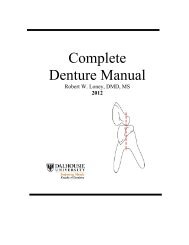RPD Manual 11 - Removable Prosthodontics - Dalhousie University
RPD Manual 11 - Removable Prosthodontics - Dalhousie University
RPD Manual 11 - Removable Prosthodontics - Dalhousie University
Create successful ePaper yourself
Turn your PDF publications into a flip-book with our unique Google optimized e-Paper software.
Anatomy Tour - 8<br />
! Soft Palate<br />
! Vibrating Line<br />
Critical posterior border of complete dentures and some partial dentures. The junction<br />
of movable and immovable portions of the soft palate. If the denture terminates<br />
posterior to this, movements of the soft palate cause it to dislodge and drop. If the<br />
denture terminates anterior to this, on the hard palate, no seal is created, the denture is<br />
unretentive and often uncomfortable.<br />
! Within a group of six students:<br />
! Have an instructor demonstrate how to find and mark the vibrating<br />
line on one student, using an indelible stick<br />
! Have an instructor draw an indelible line at an incorrect position on<br />
one of the two students and a correct position on the other, and guess<br />
which one is correct.<br />
! Locate and draw the vibrating line on the remaining students, check<br />
with instructor.<br />
! Fovea Palatini<br />
Bilateral indentations near the midline of the soft palate. Close to the vibrating line in<br />
many individuals, but not accurate enough for using as a landmark for the posterior<br />
border of the denture<br />
! Median Palatine Raphe (midline palatine suture)<br />
a. A bony midline structure, that can be raised and may require relief when covered<br />
by a denture. Covered with thin mucosa and can ulcerate easily if impinged upon.<br />
b. Occasionally a torus palatinus may be present, creating similar, often more<br />
pronounced problems.<br />
! Identify who has the most prominent raphe/torus ________________________<br />
MANDIBLE:<br />
! Pear Shaped Pad<br />
A soft pad containing glandular tissue, with an inverted pear shape, which is the<br />
posterior terminus of the mandibular complete dentures and Class I & II partial<br />
dentures. The pear shaped pad is usually created from scarring after extractions, and is<br />
therefore more easily seen in edentulous casts.<br />
! Identify the retromolar area or pad on a partner, and have an instructor check.<br />
! Identify the pear shaped pad on the distributed cast<br />
! Buccal Shelf<br />
The primary denture bearing area of a mandibular denture.<br />
Between extraction sites of molars and the external oblique ridge. Does not tend to<br />
resorb much.<br />
! Identify on a partner.















